How to build a strong brand identity
Roberta Zaccaria and Sara Mirone, WGDS founders, have given an interview to ICCIUK about how good digital design and efficient architecture play an instrumental role in building a strong brand identity and, consequently, a company’s growth and success.

Brand Identity
Q: With an ever more increasing shift towards digitalisation, you give digital services that have now become fundamental for a company’s establishment and growth. Could you explain what your services consist of and how design and architecture play a fundamental role in what you do?
WGDS helps businesses to navigate their digital transformation with bespoke web & marketing solutions. We offer various services: Brand and Marketing Strategy, Web Development, Digital Brand Audit, Google Analytics data analysis, SEO (Search Engine Optimization) and Content optimization to support businesses’ growth consistently and organically.
When a brand comes to us asking for help with rebranding, usually a website remake/makeover, we start by studying the business mission and vision, what are the business goals, what problems the website has to solve and what functionality the website needs.
We approach the project with the same mentality as an architect will do: what type of business will be occupying the space (digital in this case) and how the foundation of the house (website) needs to be for future goals (e-commerce, for example). Then we propose a website that reflects the brand identity and offers the best structure considering future developments. Once the website is online, we deliver Brand Strategy Guidelines to enforce brand awareness and a Digital Road Map for the following six months.
Creativity & Design
Q: While creativity plays a major role in helping a company build its unique brand personality, functionality is an essential item in the design formula to guarantee users’ accessibility. How do you let creativity and design functionality coexist?
Graphic design is a perfect marriage of creativity and function. As creativity is a key ingredient to ensure that the brand website stands out from the crowd, functionality is the key ingredient to ensure an efficient user experience and a clear call to action. Both are essential parts of website planning. For example, if you have a page that looks beautiful but it confuses your users, and they leave without filling out a form or buying something, that page is not doing its job. At the same time, you can have a perfectly functional page, but your brand identity is not represented in full (bad quality pictures, incoherent colour scheme, not clear purpose message), so the user will leave without completing any action. As architects do for a building, when we start any website project, we always think about function first and then integrate it with the ‘sexy’ and appealing look.
Sustainability
Q: Nowadays, sustainability represents a crucial aspect of a company’s success. How does sustainability fit into your digital spaces?
Indeed, sustainability is now the key driver for innovation. Today more and more consumers and investors are thinking beyond price and quality. People started caring about how and if a pair of jeans is made abroad or with zero footprints or if the food is ethically sourced. Investors care about and support companies with an ethical approach.
As sustainability is becoming a must, it needs to be integrated into the Digital Marketing Strategy with successful storytelling that speaks to your audience.
We promote sustainability; we love to work with brands to help them enlighten their sustainability close to their purpose. Whatever your business’s sustainable approach is, using local artisans, supporting a cause, looking after your employees’ well-being or recycling, this should be part of your brand and marketing strategy.
Digitalisation
Q: The digital world is an unstoppable space, continuously evolving and acquiring new forms and design trends. How is WGDS keeping up with this continuous evolution and, at the same time, able to offer the market’s latest trends to satisfy its clients?
It’s important to be updated on marketing trends, know the last social media channels, and recognize which one has more engagement or what is the latest Artificial Intelligence app on the market. Said that the crucial thing is to understand the needs of the client and offer the most appropriate platform, strategy and trends.
For example, Snapchat and Tik Tok are two of the latest trends in social media, with a majority of their users between 16-24 years old, so it wouldn’t make sense for a brand that sells products targeted to middle-aged business managers to use them.
As digitalisation is really unstoppable, especially in the last two years, companies must rethink their strategy to keep up with consumer behaviour, rapidly shifting from in-store to online shopping.
Some of WGDS’s last Projects ZainoFood, Proseccocaffe, Akub restaurant, AWM, Cabbiavoli Estate, RF Fitness, Rusi Designs, Il Circolo London, WorkSpa Wellbening Services for Corporate, Open Stent Solution Marketing Strategy for Cornelis Valve Fundraising, Moving to Italy.
The benefit of Digitalisation to the Education sector
We are happy to start a new series of interviews on how digitalisation has impacted Brands and People. We had the pleasure to interview two top independent, co-ed schools in London, Latymer and Alleyn’s. Today we are happy to share the conversation between Sara Mirone and Simona Tappi from WGDS with Natasha Nolan and Caroline Roberts from Latymer Upper.

How has digitalisation changed your mode of communication?
Thanks to a long process of digitalisation, our mode of communication has become better and more efficient with the outside world.
Over the past decade, Latymer Prep and Upper Schools and the Latymer Foundation have been evolving their platforms following the digital transformation enabling accessible and immediate communication with the Latymer Community whether you are a parent a donor or an alumni.
1. Parents
First, in 2015 the Prep and the Upper Schools moved parent and student communications to the SchoolPost system. This platform removes the need for printing paper forms which are sent home in school bags and instead enables secure two-way communication between the School and our parents and/or students. As well as emails and SMS messaging, a major benefit is that the school can create customised reply and/or consent forms which parents can complete and return online, making the process much more efficient and straightforward for parents and the Schools.
Later in 2019, the SchoolPost system has been complemented by our Latymer Parent Portal. This MSP (My School Portal) platform is a user-friendly dashboard that enables parents to have instant access to information about their child’s education, sport and activities. The integration of the Parent Portal and the SchoolPost systems was a natural step to permit the parents to keep track of all their communications in one place.
Similarly, we are constantly reviewing our engagement with our other platforms, namely our website and social media, and are increasing our production and use of video format to document school life and amplify our students’ voices across these mediums.
2. Donors
Last October, we sent out our main physical mailing to fewer segments than in previous years, which has reduced costs. As a result, we found that younger alumni responded better to an appeal by email than by mail. However, people do keep physical brochures and gift forms and often send in donations months later, so we will maintain the physical element of the mailing. We follow this mailing with a series of e-appeals, the first one being in the next few weeks.
Traditionally, we would send physical thank you letters to our donors, but during the pandemic that wasn’t possible, so we moved to send the letters via email. We found that donors responded more often to an email than to a mailed letter, so we have continued to send letters via email, again digitalisation helped us!
3. Alumni
We use the social networking platform Graduway to communicate with our alumni community. Our version is called Latymer Connects. We have just over 3,000 members although our weekly Latymer Connects alumni newsletter reaches around 5,000 alumni. The platform includes groups around our global Latymerian Councils in various countries and universities which encourages Latymerians to contact fellow alumni for support or advice. We also have a jobs page, where alumni post vacancies and often recruit fellow Latymerians. We are in the process of developing an online digital archive with Preservica, the aim of which is to encourage our alumni to upload their memorabilia onto a platform that can be shared with the Latymerian community.
4. Fundraising initiatives
Events have always been in person, but when the pandemic hit we adapted quickly and moved whatever events we could online. We developed a new initiative, the ‘Virtually Speaking’ Series on online talks which has already raised over £30,000 for our bursary appeal and has been really popular with our students, parents and alumni. The talks enabled us to communicate with our community worldwide over the various lockdowns. Since the pandemic restrictions eased, we have run hybrid events as people join from overseas (for example, people joined from US and Australia for our last event). Last month we ran “Does Art Matter” with an in-person audience and also a live stream, with almost 100 attendees at Latymer and 50 online. People now ask if they can join online when they wouldn’t before.
We are currently planning a fundraising initiative for our Year 10 students, with all profits going to bursaries, and plan to use Google Sites as an advertising platform coupled with a donation button.
What is the best social media platform to reach both students and parents as well as potential donors?
Over the last few years, the School and the Foundation have grown their presence on social media very organically. Currently, both the Latymer Upper and Prep Schools and the Latymer Foundation have their own Twitter, Facebook and Instagram accounts and we share a LinkedIn account.
We have been working to improve and increase the quality, volume and frequency of our content and have seen a growth in our audiences and engagements. We are constantly reviewing our social media and looking at how we can improve engagement with our community and improve the ‘user journey’ so that people can easily find the information they’re interested in.
A good recent example of this is setting up Linktree on our Instagram accounts last year which has increased traffic through to our websites. The links in the bio signpost people to the content they are interested in on our websites – whether that is student/alumni successes, events, our bursary programme, Inspiring Minds campaign, our partnership work locally and/or how they can support or get involved in our outreach programmes. We use our Youtube channel as a depository for content and are also looking at how we might make this work better for us, for example, we are currently working with the Latymer Classics Society to develop a ‘Classics playlist’ that can be shared with local partner schools.
You can follow Latymer on Instagram, Twitter and LinkedIn.
At WGDS we help businesses to navigate the digital transformation by adjusting their Brand Strategy during this unusual time, any questions contact us.

